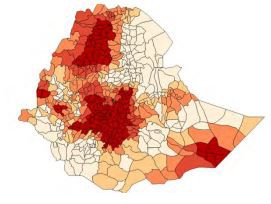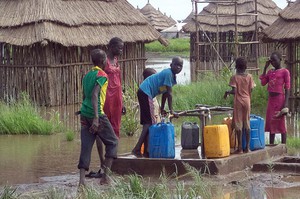Floods
Floods are extreme weather events that have had major effects in Ethiopia at different times and in different locations. In recent decades, major floods outside the normal pattern of flooding have occurred in Ethiopia with increasing frequency (EM-DAT, n.d.). They have been responsible for many deaths of people and livestock, and caused damage to homes (Figure 10.1), livelihoods and infrastructure in many parts of the country (MoWR/NMA, 2007). Table 10.1 shows the costs of major flood events in 2005 and 2006, which were the worst in recent years in terms of deaths and economic damage in Ethiopia.

Figure 10.1 Homes damaged by the 2006 flood in Gambela town, Ethiopia.
Table 10.1 Some impacts of the 2005 and 2006 floods in Ethiopia. (EM-DAT, n.d.)
| Year | Region/towns affected | Human deaths | Total affected people | Costs due to flood damage ($US) |
| 2005 | Somali region, Dire Dawa and Wolayta zone, Humbo woreda | 211 | 242,418 | 6,200,000 |
| 2006 | Eastern Afar, Eastern Somali, Tigray, Gambela, Omo, Amhara and SNNPR regions; Dire Dawa city, Addis Ababa | 951 | 434,146 | 3,200,000 |
There are two main types of floods – flash floods and river floods – both of which affect water supply and sanitation.
Flash floods and their causes
Flash floods are floods that happen as a result of intense rainfall in a localised area and they usually drain away quite quickly (Few, 2006). If a large amount of rain falls onto the land in a short time and it cannot soak into (infiltrate) the soil, the water runs downhill across the land surface. This heavy flow of surface run-off can cause a flash flood.
There are many factors that increase the risk of flash floods in Ethiopia, including changes in land use and poor soil permeability (Abaya et al., 2009). As you read in Study Session 6, when forests and grasslands are removed for the construction of roads and buildings, permeable soil is replacedby hard surfaces such as concrete. This reduces the infiltration of water into the ground and increases run-off,making flooding more likely. The proportion of Ethiopia’s land area that is covered by forests has decreased significantly in recent decades, as Study Session 1 demonstrated (see Figure 1.3).
How do forests help rain to soak into the soil?
Forests play an important role in the water cycle because the roots of plants reach deep into the soil and create space between soil particles; this increases soil permeability, so when it rains the water can infiltrate the soil.
Failures of dams and reservoirs can also lead to flash floods. Many micro-dams have been constructed in Ethiopia for irrigation, water supply and generating hydroelectric power. Dam failure can occur if they are not properly constructed, or heavy rainfall may cause ‘overtopping’ (water flowing over the top of the dam when it is full).
Flash flooding has happened many times, in many parts of Ethiopia. This causes significant harm to human life and property because it happens so unexpectedly and local people are unprepared (Greenough et al., 2001). For example, the flash flood on 5 August 2006 in Dire Dawa caused 256 deaths and displaced 9956 people (Early Warning Department, Federal Disaster Prevention and Preparedness Agency, 2007).
River floods and their causes
River floods occur when the water level rises and water spills over the top of the river banks. The overflow runs into nearby low-lying areas, where it collects as flood water (Douben, 2006). River floods in Ethiopia generally occur because of intense heavy rain at high altitudes, which results in water flowing down into lowland rivers, which then burst their banks. Unlike flash floods, river floods tend to build up slowly, but they remain for much longer periods. Figure 10.2 shows river floods in Dire Dawa and Gambela.

Figure 10.2 Floods in (a) DireDawa and (b) Gambela in 2006, resulting from the overflow of the Dechatu and Gambela rivers respectively.
Look at the map in Figure 10.3. Which parts of Ethiopia are prone to flooding?
The main flood prone areas in Ethiopia are in the centre of the country in parts of SNNPR and Oromia, in the north in Amhara region and in the south-east in Somali region.

Figure 10.3 Flood-prone areas in Ethiopia. Areas shaded in the darkest colour are at the greatest risk of flooding. (EDRI/GGGI, 2015)
The impacts of river floods depend on many factors, such as the presence of early warning systems (Bonacci and Ljubenkov, 2008). There is no effective early warning system in place in most flood-prone areas of Ethiopia, but rural communities can reduce the impact, for example by moving livestock to higher ground at the start of the flood season. But this precaution is only effective for the normal intensity and frequency of floods – it cannot deal with unusually extreme flooding – and people in urban communities are usually unable to take any action to avoid flood damage.
The severity of flooding is increased by the absence of vegetation, intensive farming methods and deforestation, all of which increase soil erosion. Bare soil is more easily washed away by heavy rain than soil that is held together by the roots of trees and other plants. Soil erosion is the main cause of increased amounts of sediment in many Ethiopian reservoirs. As soil is washed off the land into the reservoir, sediment builds up behind the dam and it can significantly reduce the reservoir capacity, leaving the dam less able to withstand a major flood.
The impact of floods on WASH in Ethiopia
Floods often cause major damage to basic facilities such as water supplies, sanitation, waste disposal systems and other essential services. This poses a serious challenge to public health. Excessive rain and flooding can create conditions that increase the spread of faecal-oral diseases because flood waters flush pathogens and pollutants into water supplies from flooded latrines and places used for open defecation.
As well as polluting water sources, floods also can damage shallow wells, boreholes fitted with windmills, and protected springs, and they can wash away water pipes (Ethiopia Red Cross/Red Crescent, 2005). The result is that people are unable to access safe drinking water unless temporary water supplies can be provided (Figure 10.4).

Figure 10.4 Children fetch water from a water point constructed after flooding by the Lutheran World Federations.